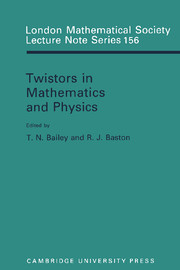Book contents
- Frontmatter
- Preface
- Contents
- 1 Twistor Theory After 25 Years—its Physical Status and Prospects
- 2 Between Integral Geometry and Twistors
- 3 Generalized Conformal Structures
- 4 Riemannian Twistor Spaces and Holonomy Groups
- 5 Twistors, Ambitwistors, and Conformal Gravity
- 6 The Penrose Transform
- 7 Notation for the Penrose Transform
- 8 The Twistor Transform
- 9 Invariant Operators
- 10 Penrose's Quasi-local Mass
- 11 The Sparling 3-form, Ashtekar Variables and Quasi-local Mass
- 12 Twistors and Strings
- 13 Integrable Systems in Twistor Theory
- 14 Twistor Characterization of Stationary Axisymmetric Solutions of Einstein's Equations
- 15 A Two-surface Encoding of Radiative Space-times
- 16 Twistors, Massless Fields and the Penrose Transform
- 17 Twistor Diagrams and Feynman Diagrams
- 18 Cohomology and Twistor Diagrams
- Authors' addresses
16 - Twistors, Massless Fields and the Penrose Transform
Published online by Cambridge University Press: 05 May 2013
- Frontmatter
- Preface
- Contents
- 1 Twistor Theory After 25 Years—its Physical Status and Prospects
- 2 Between Integral Geometry and Twistors
- 3 Generalized Conformal Structures
- 4 Riemannian Twistor Spaces and Holonomy Groups
- 5 Twistors, Ambitwistors, and Conformal Gravity
- 6 The Penrose Transform
- 7 Notation for the Penrose Transform
- 8 The Twistor Transform
- 9 Invariant Operators
- 10 Penrose's Quasi-local Mass
- 11 The Sparling 3-form, Ashtekar Variables and Quasi-local Mass
- 12 Twistors and Strings
- 13 Integrable Systems in Twistor Theory
- 14 Twistor Characterization of Stationary Axisymmetric Solutions of Einstein's Equations
- 15 A Two-surface Encoding of Radiative Space-times
- 16 Twistors, Massless Fields and the Penrose Transform
- 17 Twistor Diagrams and Feynman Diagrams
- 18 Cohomology and Twistor Diagrams
- Authors' addresses
Summary
Introduction and Notation
The aim of this review is twofold. Firstly we wish to discuss some of the advances in the twistor theory of massless fields that have happened since the original cohomological treatment by Eastwood, Penrose and Wells [20], particularly in the areas of non-analytic fields and their relation to quantum field theory, and fields with sources. Another advance is that representation theory methods have been introduced which give a particularly effective means of computing isomorphisms between cohomology and solutions of field equations. These methods have been studied in considerable generality [9] and the second aim of this review is to present the particular cases of interest to twistor physics in sufficient detail to enable non-representation theorists to perform the computations.
We will give only the barest outline of the background here, as it is our intention to take the original cohomological treatment of twistor theory by Eastwood, Penrose and Wells [20] as our starting point. Twistor theory originated as a reformulation of relativistic physics which, it was hoped, would make directions for progress in physics more apparent. From a mathematical point of view, the fundamental observation is that if one takes Minkowski space and complexifies and compactifies it, then it can be identified as the Grassmannian M = Gr2(T), i.e. the space of (complex) two dimensional subspaces of T, a four (complex) dimensional vector space.
- Type
- Chapter
- Information
- Twistors in Mathematics and Physics , pp. 299 - 338Publisher: Cambridge University PressPrint publication year: 1990
- 4
- Cited by

